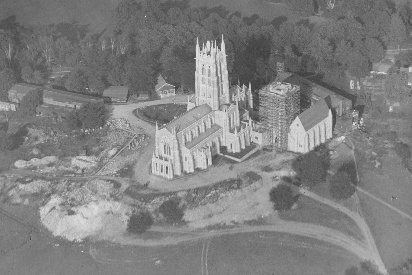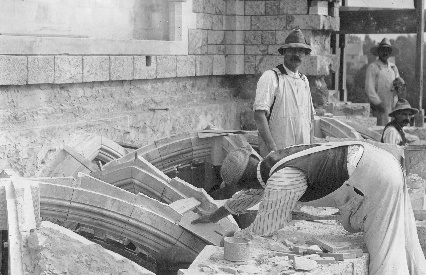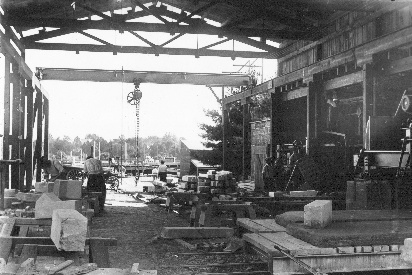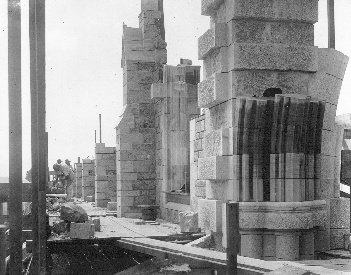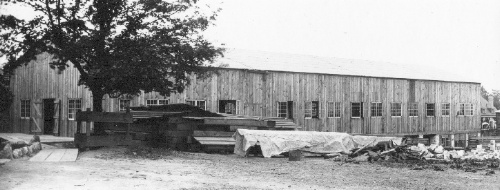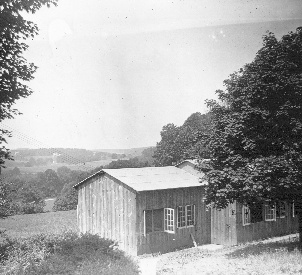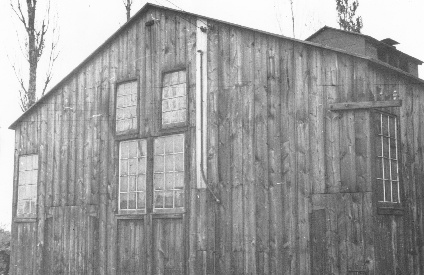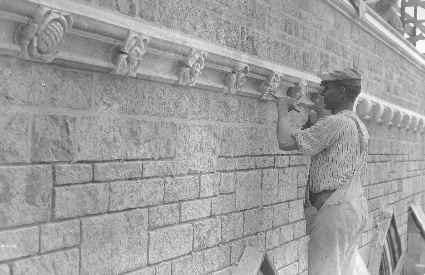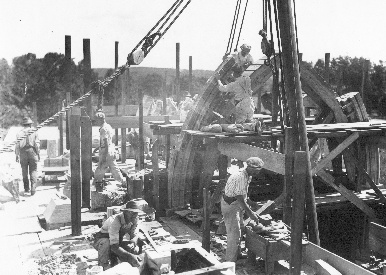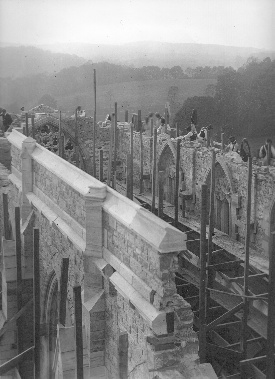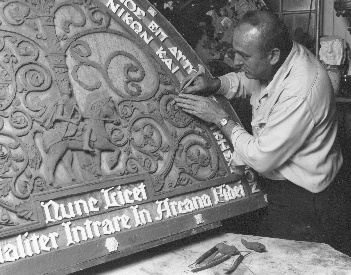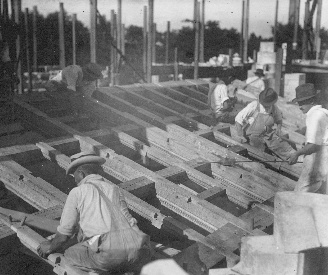Bryn Athyn Cathedral: The Building of a Church
E. Bruce Glenn
Shops and Artisans
ORGANIC DESIGN that grows with time needs a correspondingly flexible building organization. In practical terms, this means a rejection of the general contract pattern of shaping and fitting together the materials of a structure for a fixed sum, in favor of direct employment, on a time basis, of the artisans and workers. As such, it is yet another step away from modern building economy toward the goal of care and quality in workmanship—a step backward, though only in time, to the building of the medieval cathedrals. Of this, the "Gothic way," Kingsley Porter has written:
The thirteenth century not only produced a few buildings which equal the best produced at any other period, but everything executed at that time was on nearly the same level of excellence. . . . No one could produce bad work. To the individualist of the twentieth century this condition of affairs is unthinkable. Yet the fact remains that in the Gothic period the most remote country churches, the most insignificant buildings, show the same exquisite detail, the same unerring sense of beauty as the great cathedrals.1
Could such a result be hoped for in a twentieth century country church of eastern Pennsylvania? Raymond Pitcairn dared to believe it could—that here was an unparalleled opportunity in modern building practice—to break away from the stultifying tradition of the general contractor, and to bring once more into being the ideal of craftsmanship expressed in the dedicated work of the medieval guilds.
Caught up in the spirit of this ideal, R.A. Cram wrote to Pitcairn in August 1913 proposing the establishment of such a guild on the cathedral site for the making of the stained glass windows and furniture. But Pitcairn was faced with a more immediate and far-reaching situation—the building itself, already under construction. The search for suitable materials was well under way. Down the creek valley half a mile from the site a granite quarry had been opened that gave exciting promise of beautiful walls erected out of local materials. And within a radius of twenty miles from Bryn Athyn, great white oaks were already being felled in anticipation of a solid timber roof for the church. The moment was at hand for a decision that would vitally affect the nature and quality of the completed structure many years hence: what kind of building organization should be formed to shape and erect it?
This aerial view of the Cathedral shows the Ezekiel Tower fenced with scaffolding. The great stone shed is at the left, the carpenter shop beyond the Council Hall on the right. The architectural studio is hidden by the main tower; the metal shop is off to the left, down the hilly road; and the glass-making shop lies beyond the road glimpsed at upper right. The time is 1924, a date firmly established by the broken pinnacle at the northeast corner of the tower. Struck by lightning following a wedding one evening, the top plunged through the roof and landed where the organist had been playing less than an hour before. Click on image for a larger version.
Spurred by Cram's proposal, Pitcairn pressed for further details of the guild system "as far as you deem it feasible for Bryn Athyn, and we hope to receive it before it is necessary to decide what plan of contracting we shall adopt."2
Cram had already proposed that the building work be let to separate contractors, each to be selected for quality in a special line; but as this entailed central responsibility on somebody's part, and as the firm of Cram and Ferguson declined to accept that responsibility, the situation became more and more problematical. Pitcairn had not yet determined to devote his whole time to the church; nor had he the background to conduct his own contracting or to coordinate the work of several contractors under separate agreements. Yet the alternative was to call in a general contractor; and this meant a curtailing of design development, a narrowing of the search for the most fitting and beautiful materials, and the separation of the craftsman both from the designer and from the building to which he was contributing. One disappointed general contractor assured Pitcairn that any other course would lead him to a sanitarium. Receiving scant practical support for his vision from the architects in faraway Boston, Pitcairn turned to a fellow member of the General Church, Edwin T. Asplundh, who had just established an engineering practice in the State of Washington. Asplundh astutely summed up the needs of the situation in his reply:
That a general contractor for the work will be dispensed with, and that as far as possible from a practical and economical standpoint the work will be done at cost, under the supervision of an engineer representing the Church.
And he added, "I assure you that I will be very glad to offer my services."3
These workmen, typical of the crowd that trooped up the hill to the church from the Bryn Athyn railroad station each day, are setting the ribs for the vaulted roof of the west porch, beneath the west window. Click on image for a larger version.
It was to prove a fruitful association, in which Asplundh worked closely with Pitcairn to bring the latter's dream to realization by developing an organization of men whose hallmark, like that of the medieval guilds, was integrity in performance and quality of result. These two men shared a common purpose imbued with a mutually held faith in Him whose temple they were building. Under their daily aspiration and direction, men of many faiths and talents came together in Bryn Athyn—a group, like the cathedral itself, of slow and careful growth, working in a harmony of individual talents, "side by side, eye to eye"4 in the shops that clustered for two decades around the cathedral. It has been frequently reported that the purpose of this organization was a social one, the establishment of guilds as an experiment in medievalism. This was not at all the fact; it was rather that only by such a method of building could a church of the twentieth century be erected with the same integrity, "the same unerring sense of beauty as the great cathedrals."5
Looking out through the open end of the stone shed. Here the irregular rhythm of chisel against granite produced a cheerful music all day long. Click on image for a larger version.
It is perhaps fitting here to note that Edwin Asplundh, who left the supervision of construction at Bryn Athyn in 1917 to serve in the First World War, returned to work closely with Raymond Pitcairn in other fields. After many years of service, he completed his career as Chairman of the Board of Pittsburgh Plate Glass Company, the firm founded by John Pitcairn.
In the foreground a rising tower pier reveals the intricacies of design and execution, in the uniting of utilitarian strength with formal beauty. Beyond stand the buttresses of the nave clerestory. Click on image for a larger version.
In the fall of 1913 Pitcairn wrote to Cram of his desire for "that human and expressive variation which makes pictures of walls and will make all parts of the church a real expression of art. I believe that by personal suggestion to the workmen and by the right kind of inspiration all through the work, a man can put just as much into a church like ours as there is in him."6
How different a concept was this from that of separated and mechanical functions which has seized our age in an iron grip, and under which a man hewing stone or timber seldom knows of the destination of his work or the nature of the structure in which it will stand.
And so the work of building went forward with renewed confidence and a growing enthusiasm at the site. The Bryn Athyn quarry was fully opened, from which came the stone for the outer walls of the main church building and much of the granite in other portions of the cathedral. Shops were erected convenient to the rising walls, and a rapidly growing group of stone workers—masons and cut stone artisans—worked diligently to shape by hand this oldest and most steadfast of building materials, lying providentially so close at hand. Bryn Athyn's air was filled, in the long summer days of 1914, with the sharp, pleasant tinkle of hammer and chisel upon stone. To do this work, two Philadelphia stone contractors had been selected because of the quality of their product, and brought under separate contracts to Bryn Athyn. Pringle Borthwick, the masonry contractor, contributed valuable and sympathetic service for a number of years, until in 1917 his contract was terminated. The organization had become so integral a part of the Bryn Athyn work that his services were by that time simply those of advisor making weekly visits, with supervision, hiring, and compensation fully under the control of the church office.
The cut stone work was put under contract to William Ridgeway, whose association with the church building continued until the cut stone work for the main church was completed in 1919. This relationship was equally cordial and increasingly informal, with the Bryn Athyn administration placing the men and supervising their work as if directly employing them.
The carpenter shop, or woodworking shed, was the last major workshop standing. Its final use was as a meeting hall for the 1950 Assembly of the General Church. The modeling shop was housed in the lower end at ground level. Click on image for a larger version.
The metal shop still stands below the church to the north, on the hillside sloping to the Pennypack Creek. It is now used for the variety of crafts needed to finish doors and other furnishings still being designed and placed in the Cathedral. Click on image for a larger version.
One end of the glass-making shop, situated across Huntingdon Pike from the Cathedral grounds. Its site is now a gravel parking area near the tennis courts of the Academy, where bright pieces of colored glass may still be found imbedded. Click on image for a larger version.
Other groups were to join these as the need arose with the rising cathedral. The great oak trees for roof beams and planks were seasoning under cover by this time; and as they were brought, roughly squared for transport, down the pike from a saw mill on the Neshaminy a few miles north, a woodworking shop, directly organized in Bryn Athyn, joined the stone workers in the task of hand shaping and joining the church's basic structure. Still later, a metal shop and finally a glass shop for mixing of formulas and blowing of stained glass were added. Amid all these stood the central drafting office, where as time went on, more and more of the general and detailed design work was being carried out on the site. Not least in importance was the modeling shop, where design met the trial of three-dimensional projection, and where those concerned with execution could render experienced criticism.
That such an organization could be developed at all was an audacious hope. That it succeeded was a tribute to cooperation and perseverance at all levels of the work, a tribute underscored by the wistful legend that its chief end was a return to the craft guilds of old. What these men accomplished in their years of striving at Bryn Athyn can only be expressed in the cathedral building itself, the true end which they served. The specific materials brought to Bryn Athyn, and the ways of their fashioning will be treated in separate following chapters; but the reader who has not stood and looked upon the work itself will be justly warned by Kingsley Porter's statement to Pitcairn, written from France where he was engaged in cathedral restoration following World War I: "The very fact that photographs cannot reproduce the charm of Bryn Athyn makes it difficult to render it comprehensible to people who have not seen it."7 If this be true of photographs, how much more must words be inadequate to the task.
If the execution itself must be seen for full appreciation, so also must presence in Bryn Athyn have been necessary to catch the full atmosphere of the enterprise. We must recapture what we can of the feeling, from notes and letters, remembering that the church as it stands bears vivid witness to the love and skill that marked its building.
It was a halcyon time, though not without its rainy days. The growing dissidence in the office of the original architects, who clearly did not grasp the pertinence of what was going on in Bryn Athyn, did little to disturb the sphere on the Pennsylvania hill, beyond the breaking storm of recrimination that followed Cram's final severance from the enterprise early in 1917. Amid the work itself there was little of the altercation that frequently accompanies the complex endeavors of many human minds and hands over a long duration. Emulation need not beget envy, if the mutual end is urged strongly enough and the satisfaction is granted of doing one's own part as well and fully as ability allows. And both emulation and satisfaction were given room at Bryn Athyn. Raymond Pitcairn's correspondence with architectural designers and artisans is full of such statements as the following: To one of the designers in Cram's office,
What is most needed in work of the character which we are doing, is thought on the part of those engaged directly and indirectly upon the work, and we appreciate most fully a frank and sincere opinion from anyone qualified to give us constructive criticism.8
To the head of the modeling shop,
I should like to have you make models for grape leaf design for the remaining chancel column capitals. . . . When you have worked out the models carefully, I would get the criticism of Meng[hi] and Tweedale and the other fellows, and then proceed to carve these capitals. . . .9
Note that the final carving is to proceed upon the joint consultation of the men whose hands did the work; no autocratic design is copied, no designer must mark "O.K." on drawing or model.
A striking picture of the artisan working in full view of the whole for which he is creating a part, in happy contrast to the divisive practices of modern economy. He is carving rosettes from solid blocks of limestone—rosettes that will run in endless variety around the nave just below the cornice. Click on image for a larger version.
Of Pitcairn's own contributions to such developing work, the following is a modest definition:
For the particular results which we are striving for in Bryn Athyn it is best to work with stone and wood carvers and others who actually execute work from their own models, in the making of which I collaborate and supervise.10
Setting the sanctuary arch: individual energies directed to a single end. Click on image for a larger version.
It was one of Cram's contentions that such a system—the looseness of which he greatly exaggerated in written statements that had not the benefit of being close to the work—could not succeed. This notwithstanding the acknowledged fact that it was the way of the medieval builders. As Pitcairn explained in a letter to a would-be Bryn Athyn sculptor, "I am thoroughly convinced that in order for this work to have the artistic life and spirit of the early Gothic sculpture, it should be executed in stone by the artist who makes the models or studies."11 Mind and hand were to go undivorced and out of such a union lasting fruits are born, today as seven centuries ago. Pitcairn pointed out the reason in a letter to his brother Theo, written three years after the main church was finished:
Our experience at the Church confirms fully what Emile Male says with regard to mediaeval art, to the effect that an artist who is sincerely working along lines of a wonderful tradition can produce a work of art which has a strong emotional appeal, although he might fail to prove himself a great artist if he endeavored to be an individualist.12
High above the ground, stone masons work on the nave clerestory wall, with peaceful hills unfolding to the west. The limestone weatherings stand out against the Bryn Athyn granite quarried in the woods beyond the first hill. Click on image for a larger version.
And finally, to one of the suppliers of stone for later work in the Council Hall, he wrote: "It was Carlyle who said that 'Genius is an immense capacity for taking pains.' If we are not all geniuses, we can at least display some of that great capacity for taking pains and develop some of that enthusiasm, without which no great thing was ever accomplished."13
This was the spirit that filled the air at Bryn Athyn, and made of a building operation a community of men, well over a hundred in number. Some of these lived in or near Bryn Athyn; most were part of the daily procession that trooped, chattering in several tongues, up from the Bryn Athyn station to the church hill in the morning and back at night to take the steam train to Philadelphia. In fact, this procession of workers was given official status by the railroad in July 1914, when that inexorable ruler, the train schedule, was altered to accommodate their evening transportation from work.
How did these men feel about the work they were doing? Let one speak, in words carefully sought out years afterward to recapture the fact; and then let his action at the time speak to us for him. Benjamin Tweedale came in 1916 to work for three months as a carver; he stayed for twenty years, cutting tracery and capitals with a sure and delicate Scottish hand. In his retirement he recalled the difference between this and other jobs he had done. "Others worked to meet a deadline for the profit of the contractor. They figured costs and ordered the job done. Here with Mr. Pitcairn excellence in the work was everything. He demanded truth and honesty, for these were what the church stood for."14
The only time Tweedale ever quit the job was because of a failure on his own part. In carving the base of a column for the nave, he made a slight mishit with his mallet, flawing the stone. It might have been worked into acceptability; but the carver, despondent, put down his tools and went home, he thought not to return. That evening Pitcairn called him on the telephone, commending his integrity and asking him to come back.
The creative endeavor still continues. This recent photograph is of the modeling of the tympanum to be placed above a new west door, of glass and monel, to replace the plain oak door hung "temporarily" in 1919. Click on image for a larger version.
Problems were met as they arose. A new tool was made by one of the blacksmiths on the job, an adze with a curved blade to hand-finish the surfaces of the great roof timbers. Second effort was the accepted course if a first did not succeed. A night letter from Edwin Asplundh is laconic in its summation of difficulties:
Ohio stone Company have not got the stone. Cleveland Stone Company cannot ship for six weeks. I will investigate a quarry eighty miles from here[,] if I can make connections I will be back Sunday morning.15
The good nature of nearly everyone concerned was unflagging. Early problems were summed up by Asplundh in a "progress report" to Pitcairn while the latter was vacationing in the summer of 1914:
Rain, no stone, coal delivery, team trouble, broken wagons, balky crusher, no water, broken steam lines, hunting houses for Italians, and checking the monthly statement.
He adds, "All the above troubles have either had a short existence or else one of indefinite duration."16
Placing the north aisle roof of the nave. The original roof, assembled in the carpenter shop, was destroyed by fire in 1916, and this new roof was made ready in months of hand labor. The man in the foreground is sawing off the protruding ends of locust wood pegs used to fasten purlins and rafters together. Click on image for a larger version.
Perhaps the major test of the building organization in the way of reversal of progress was a fire in April of 1916. Occurring in the dead of a Saturday night, it spread from the metal forge to the timber-working shed. Although the administration and architectural offices were saved by volunteer firemen, the timber shed was completely destroyed, together with a major portion of the north aisle roof for the nave and a completed bay of the central nave roof.
This loss of seasoned oak, hand-hewn and much of it mortised for placement in the church, was a sharp blow. Also lost were all the models then standing in the shed, and the wood-workers' tool kits, the instruments of their careful art. Yet by mid-June, less than two months later, the north aisle roof, redesigned and entirely hand-worked on the site, was in place in the church. Nor was this a hurried job of patchwork construction, as is evidenced by inspection of the roof and comparison with the south aisle roof completed earlier. Raymond Pitcairn, in letters to Edwin Asplundh and Harry Bowman, foreman of the group, expressed grateful surprise at the quick recovery from this setback. It is perhaps most effectively explained by a simple letter addressed to John Pitcairn soon after the fire and signed, appropriately in pencil, by all eighteen of the carpenters:
My dear Sir,
Words cannot express our appreciation of the great kindness you have done us in supplying each one with a new Box of Tools. We can only say that we feel greatly indebted to you.
Yours most respectfully17
A small thing, it might easily be said in this day of mass union benefits; but that may be exactly the moral of the story. Here was an example of a very human relationship, with personal concern and mutual confidence between owner and workmen. It was emblematic of the spirit, the esprit de corps in the true sense of the phrase, that accompanied the building of the Bryn Athyn Cathedral. Accompanied? Say rather the spirit that is intrinsic in the carved stone and wood, the wrought metal and glowing glass before us. It is the spirit of free cooperation which dignifies human society and blesses the work of its hand. And it is most fitting that this spirit should be brought, as it was in those years at Bryn Athyn, to the creation of a house of worship; that this work should be offered to the Divine Creator, who is the source of all truly human endeavors.
Top | Previous Chapter: Architectural Refinements and Variations | Next Chapter: The Stone Work | Table of Contents
Footnotes top
1 A. Kingsley Porter, Beyond Architecture (Boston: Marshall Jones Company, 1918), 99–100.
2 Raymond Pitcairn. Letter to Ralph Adams Cram. 13 November 1913. Glencairn Museum Archives, Bryn Athyn, PA.
3 The source for this quotation has not yet been found.
4 Raymond Pitcairn, "Bryn Athyn Church: The Manner of the Building and a Defence Thereof" (book draft, Glencairn Museum Archives), 16 (draft two).
5 A. Kingsley Porter, Beyond Architecture (Boston: Marshall Jones Company, 1918), 100.
6 Raymond Pitcairn. Letter to Ralph Adams Cram. 3 September 1913. Glencairn Museum Archives, Bryn Athyn, PA.
7 A. Kingsley Porter. Letter to Raymond Pitcairn. 25 December 1918. Glencairn Museum Archives, Bryn Athyn, PA.
8 Raymond Pitcairn. Letter to Frank E. Cleveland. 17 March 1915. Glencairn Museum Archives, Bryn Athyn, PA.
9 Raymond Pitcairn. Letter to Felice Sabatino. 23 October 1922. Glencairn Museum Archives, Bryn Athyn, PA.
10 The source for this quotation has not yet been found.
11 Raymond Pitcairn. Letter to Angelo Lualdi. 12 June 1918. Glencairn Museum Archives, Bryn Athyn, PA.
12 Raymond Pitcairn. Letter to Theodore Pitcairn. 3 April 1922. Glencairn Museum Archives, Bryn Athyn, PA.
13 Raymond Pitcairn. Letter to Mr. Corbett. 5 January 1925. Glencairn Museum Archives, Bryn Athyn, PA.
14 A written source for this quotation has not yet been found. There is evidence that E. Bruce Glenn contacted some of the craftsmen while working on the book. The quotation may have been the result of an interview between the author and Benjamin Tweedale.
15 Edwin T. Asplundh. Western Union Night Letter to Raymond Pitcairn. Handwritten date is unclear, but is possibly 29 October 1915. Glencairn Museum Archives, Bryn Athyn, PA.
16 The source for this quotation has not yet been found.
17 The source for this quotation has not yet been found.
